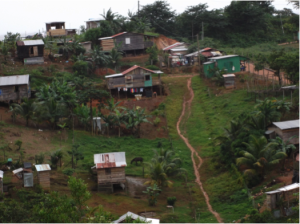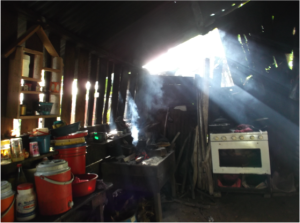Raga Neela Ayyagari
 Lunchtime in Bluefields, Nicaragua is a large production. The aromas of sizzling meat and the gritty smell of charcoal permeate through the thin wooden walls of the small, clustered houses. Groups of women and girls with young children cradled on their hips stand by their stoves, talking animatedly in the sweltering glow of the fire.
Lunchtime in Bluefields, Nicaragua is a large production. The aromas of sizzling meat and the gritty smell of charcoal permeate through the thin wooden walls of the small, clustered houses. Groups of women and girls with young children cradled on their hips stand by their stoves, talking animatedly in the sweltering glow of the fire.
From daily heaping plates of rice and beans to hearty coconut stews, cooking plays a crucial role in the community’s culture. However, while the food provides nutritional sustenance and community cohesion, the technology and process of cooking is often harmful to the families’ physical, environmental, and economic well-being.
This summer, I had the opportunity to intern with blueEnergy, a non-profit organization dedicated to improving sustainability and equity through clean energy, water, and community development projects in Bluefields, Nicaragua. During my time in Bluefields, my team interviewed over 150 families to better understand the cooking customs and needs of the community.
Cooking with open fires and furnaces is a global issue that affects human health, environmental pollution, and economic opportunity. In fact, smoke and heat from open fires is one of the leading causes of child mortality, equivalent to mothers and children smoking three packs of cigarettes a day.1 The smoke from open fires also leads to risks to health and safety such as respiratory illness and house fires.2
 As I conversed with a woman skillfully baking tortillas on an open fire, smoke infiltrated the small wooden kitchen, irritating my throat and making my eyes water. Never taking her eyes off of the browning tortillas, she described how her daughter suffers from asthma as a result of the smoke, but despite the doctor’s orders, she could not afford to cook with anything else. The majority of families I interviewed this summer also observed that the smoke and heat produced by their current stoves negatively affect their families’ health. 82% of respondents to the survey who used coal and wood to cook reported that the smoke from their stoves, especially wood stoves, bothered them, causing respiratory illness and eye irritation. Furthermore, 91% of families using coal and wood reported that the heat from the stoves bothered them and would cause burns and discoloration of their skin.
As I conversed with a woman skillfully baking tortillas on an open fire, smoke infiltrated the small wooden kitchen, irritating my throat and making my eyes water. Never taking her eyes off of the browning tortillas, she described how her daughter suffers from asthma as a result of the smoke, but despite the doctor’s orders, she could not afford to cook with anything else. The majority of families I interviewed this summer also observed that the smoke and heat produced by their current stoves negatively affect their families’ health. 82% of respondents to the survey who used coal and wood to cook reported that the smoke from their stoves, especially wood stoves, bothered them, causing respiratory illness and eye irritation. Furthermore, 91% of families using coal and wood reported that the heat from the stoves bothered them and would cause burns and discoloration of their skin.
 Although these health concerns are common, economics play a large role in the reliance on cooking with coal and wood. Nicaragua has a large amount of natural resources, but it is the second poorest country in the Western Hemisphere behind Haiti.3 Due to high rates of poverty, a large portion of the country cooks with wood and charcoal instead of gas, which is safer, but more expensive. For example, one family I interviewed removed the burners from their gas stove and used it as an open fire stove because they could not afford to pay for gas monthly. Another woman described how her family would sometimes burn plastic for fuel, releasing a black smoke that irritated her eyes and respiratory tract.
Although these health concerns are common, economics play a large role in the reliance on cooking with coal and wood. Nicaragua has a large amount of natural resources, but it is the second poorest country in the Western Hemisphere behind Haiti.3 Due to high rates of poverty, a large portion of the country cooks with wood and charcoal instead of gas, which is safer, but more expensive. For example, one family I interviewed removed the burners from their gas stove and used it as an open fire stove because they could not afford to pay for gas monthly. Another woman described how her family would sometimes burn plastic for fuel, releasing a black smoke that irritated her eyes and respiratory tract.
In addition to individual problems, the time spent collecting fuel sometimes leads to a decrease in economic productivity. The time, money, and distance taken to collect wood vary greatly. While some families collect fuel at local “pulperias” or small stores 10-15 minutes from their homes, others make trips of up to 12 hours to the farms and mountains to chop down trees for firewood. This loss of productivity is especially important for families that depend on day labor, or “chamba,” jobs for income. One respondent described with frustration how sometimes the loss of income when men were off collecting fuel meant that their family could not afford food to eat.
 Although cooking is so entrenched in the human experience that it is often overlooked, unsafe fuels and technology endanger fundamental human rights such as physical health, environmental safety, and economic prosperity. Using models that produce less smoke and heat through more efficient combustion could help reduce these health and
Although cooking is so entrenched in the human experience that it is often overlooked, unsafe fuels and technology endanger fundamental human rights such as physical health, environmental safety, and economic prosperity. Using models that produce less smoke and heat through more efficient combustion could help reduce these health and
economic impacts, especially for women and children who suffer from the highest level of exposure. Using the feedback provided by the interviews, my team researched local solutions to identified needs and economic situations. We evaluated various models of “ecostoves”, furnaces that use 50% less fuel than open fires. These models are currently being piloted by blueEnergy to assess their performance and social acceptance.
From the mothers concerned about the effects of smoke on their children’s growth to the groups of women who depend on selling food for a living, yet cannot afford gas, the stories of the respondents demonstrate how unsafe cooking technology can corrode families’ health and livelihoods like acrid smoke from an open fire stove. Further research to improve the access to improved cooking technologies can help ignite a movement for a more healthy, prosperous, and empowered community both in Bluefields and globally.
References:
1. Saving Lives and Combating Climate Change. January ;2014 ; Available at: http://www.stoveteam.org/why-stoves (Accessed October 2014 ).
2. Neira, Maria. “Household Air Pollution and Health” Paper presented at: World Health Organization: Public Health and Environment; 2013 (Accessed October 2014).
3. Rural Poverty in Nicaragua. Available at: http://www.ruralpovertyportal.org/country/home/tags/nicaragua. Accessed November 1, 2014.
